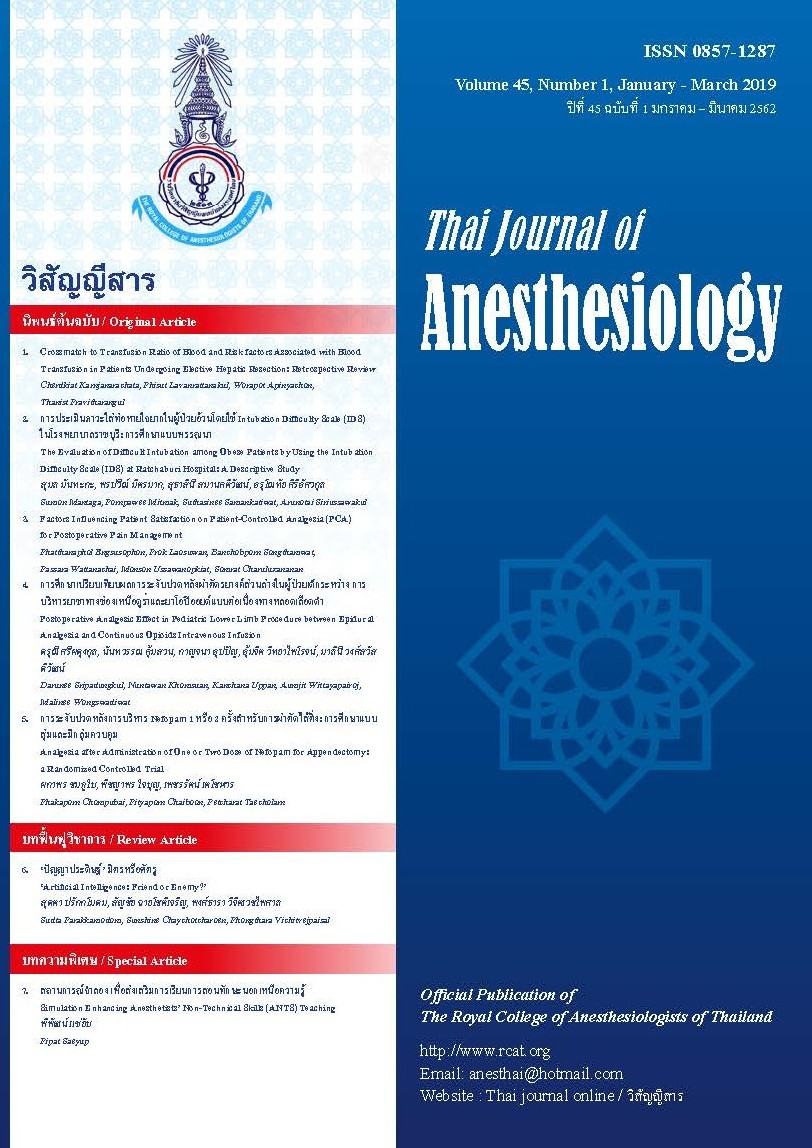The Evaluation of Difficult Intubation among Obese Patients by Using the Intubation Difficulty Scale (IDS) at Ratchaburi Hospital: A Descriptive Study
Main Article Content
Abstract
Background and Objective: The Intubation Difficulty
Scale (IDS) has been used as a research tool for more
than 10 years. The objectives of this study were to describe
degree of difficult intubation defined by the Intubation
Difficulty Scale (IDS) scores, and secondly, to study the
characteristics of obese patients who were defined as
difficult intubation and the occurrence of adverse events.
Materials and Methods: This prospective study was
conducted in patients with a body mass index (BMI) of
greater than or equal to 30 kg/m2 who underwent elective
surgery by general anesthesia with endotracheal
intubation. The IDS scoring system comprised seven
parameters; the number of attempts, the number of
operators, the number of alternative technique used, the
glottic exposure defined by Cormack-Lehane grade, the
lifting force applied during laryngoscopy, the necessity for
external laryngeal pressure, the position of vocal cord. The
interpretation of difficult intubation defined by IDS scoring
system was easy intubation (IDS score 0-1), troublesome
intubation (IDS scores 2-4), and difficult intubation
(IDS scores ≥ 5).
Results: There were 136 patients enrolled; 106 females
and 26 males. The mean age ± SD was 47 years old and
the body mass index (BMI) was 34 + 3.4 kilogram /meter2
(min 30.0 kg/m 2, max 53.3 kg/m2). There were 119 patients
(87.5%) with easy intubation, 14 patients (10.3%) with
troublesome intubation and 3 patients (2.2 %, 2 female,
1 male) with difficult intubation (IDS ≥ 5). The scores
were obtained from the Cormack-Lehane laryngoscopic
view grade 3, intubation more than 1 attempt; increased
lifting force and applied external laryngeal pressure for
optimized the vocal cord exposure. There was only one
patient experienced desaturation.
Conclusions: Intubation Difficulty Scale is an easy scoring
tool for screening patient expected difficult airway. The
incidence of difficult intubation in this study when IDS ≥ 5
in obese patient was 2.2.
Article Details
References
Chatsiriphattana A, Nimmannit A, Wong-in N. The
performance of the neck circumference for a difficult
laryngoscopy in obese patients. J Med Assoc Thai
2016;99(5):484-90.
2. Langeron O, Birenbaum A, Le Sache F, Raux M. Airway
management in obese patient. Minerva Anestesiol 2014;
80(3):382-92.
3. Kim WH, Ahn HJ, Lee CJ, Shin BS, Ko JS, Choi SJ, et al.
Neck circumference to thyromental distance ratio: a new
predictor of difficult intubation in obese patients. Br J Anaesth
2011;106(5):743-8.
4. Gonzalez H, Minville V, Delanoue K, Mazerolles M, Concina
D, Fourcade O. The importance of increased neck
circumference to intubation difficulties in obese patients.
Anesth Analg 2008;106(4):1132-6.
5. Cormack RS, Lehane J. Difficult tracheal intubation in
obstetrics. Anaesthesia 1984;39(11):1105-11.
6. Benumof JL. Management of the difficult adult airway
with special emphasis on awake tracheal intubation.
Anesthesiology 1991;75(6):1087-110.
7. Schwartz DE, Wiener-Kronish JP. Management of the difficult
airway. Clin Chest Med 1991;12(3):483-95.
8. Adnet F, Borron SW, Racine SX, et al. The intubation difficulty
scale (IDS): proposal and evaluation of a new score
characterizing the complexity of endotracheal intubation.
Anesthesiology 1997;87(6):1290-7.
9. Seo SH, Lee JG, Yu SB, Kim DS, Ryu SJ, Kim KH. Predictors
of difficult intubation defined by the intubation difficulty scale
(IDS): predictive value of 7 airway assessment factors.
Korean J Anesth 2012;63(6):491-7.
10. K Nasa V, S Kamath S. Risk factors assessment of the difficult
intubation using intubation difficulty scale (IDS). J Clin Diagn
Res 2014;8(7):Gc01-3.
11. Apfelbaum JL, Hagberg CA, Caplan RA, Blitt CD, Connis
RT, Nicknovich DG, et al. Practice guidelines for management
of the difficult airway: an updated report by the American
society of anesthesiologists task force on management of
the difficult airway. Anesthesiology 2013;118(2):251-70.
12. Siriussawakul A, Wangdee A, Chatsiriphatthana A, Komoltri
C, Dejarkom S, Jirachaipitak S, et al. Modified Mallampati
test, neck circumference and short inter-incisor gap are risk
factors for troublesome intubation in Thai obese patients.
Siriraj Med J 2017;66(6):8.
13. Koh W, Kim H, Kim K, Ro YJ, Yang HS. Encountering
unexpected difficult airway: relationship with the intubation
difficulty scale. Korean J Anesth 2016;69(3):244-9.
14. Eiamcharoenwit J, Itthisompaiboon N, Limpawattana P,
Suwanpratheep A, Siriussawakul A. The performance of neck
circumference and other airway assessment tests for the
prediction of difficult intubation in obese parturients
undergoing cesarean delivery. Int J Obstet Anesth
2017;31:45-50.
15. Krobbuaban B, Diregpoke S, Kumkeaw S, Tanomsat M. The
predictive value of the height ratio and thyromental distance:
four predictive tests for difficult laryngoscopy. Anesth Analg
2005;101(5):1542-5.
16. Ittichaikulthol W, Chanpradub S, Amnoundetchakorn S,
Arayajarernwong N, Wongkum W. Modified Mallampati test
and thyromental distance as a predictor of difficult
laryngoscopy in Thai patients. J Med Assoc Thai
2010;93(1):84-9.
17. Uerpairojkit K, Pranootnarabhal T, Punjasawadwong Y,
Chumnanvej S, Tanudsintum S, Wasinwong W, et al.
Multicentered study of model of difficult endotracheal
intubation by incident reports from university and
non-university hospitals. J Med Assoc Thai 2008;91(12):
1846-52.
18. Brodsky JB, Lemmens HJ, Brock-Utne JG, Vierra M, Saidman
LJ. Morbid obesity and tracheal intubation. Anesth Analg
2002;94(3):732-6.


